3.3.2 refraction, diffraction + interference
1/32
There's no tags or description
Looks like no tags are added yet.
Name | Mastery | Learn | Test | Matching | Spaced |
|---|
No study sessions yet.
33 Terms
define path difference and coherence
Path difference is the difference in the distance travelled by two waves.
A coherent light source has the same frequency and wavelength and a constant phase difference.
describe young’s double slit experiment
use one coherent source of light and a double slit OR two coherent sources of light in order to produce an interference pattern
2 slits about the same size as the wavelength of the laser light so the light diffracts
wave is diffracted from each slit/each slit acts as a source + these superpose
produces a pattern of light and dark fringes
characteristics of interference pattern
each bright fringe is identical and has the same width and intensity
fringes are separated by dark narrow bands of destructive interference
why are alternate maxima and minima of intensity observed?
bright fringes are formed where the light meets in phase → superpose → interferes constructively → path difference is a whole number of wavelengths (nλ) - where n is an integer → maxima
dark fringes are formed where the light meet out of phase → superpose → interferes destructively → waves in antiphase → (n+1/2)λ → minima
young’s equation
w = fringe separation
λ = wavelength of light
D - distance from slits to source
S = slit separation/spacing

effect of using white light instead of monochromatic light
central maximum is white because each wave interfered here constructively
other maxima are composed of a spectrum
shortest wavelength (violet) would appear nearest to the central maximum
longest wavelength (red) would appear furthest from the central maximum
wider maxima and less intense diffraction pattern → as it moves further away from centre, wavelengths of blue observed decrease, colours look blurry
issues associated with using lasers + safety precautions
can cause permanent damage to your eyesight
wear laser safety goggles
don’t look directly into laser
don’t shine laser at reflective surfaces
what does young’s double slit experiment prove/how understanding of EM radiation has changed over time
evidence that light is a wave because diffraction and interference are wave properties
proves that EM radiation must act as a wave (at least some of the time)
however, this is not always what people thought. knowledge and understanding of any scientific concept changes over time in accordance to the experimental evidence gathered by the scientific community.
what is diffraction
diffraction is the spreading out of waves as they pass through or around a gap.
- the greatest diffraction occurs when the gap is the same size as the wavelength
- less diffraction occurs when waves pass through a wide gap than through a narrow gap
single slit diffraction
monochromatic light can be diffracted through a single slit onto a screen, which forms an interference pattern of light and dark fringes
wavefront within the slit behaves as a series of point sources which spread circular wave fronts from them
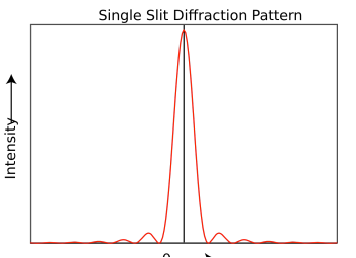
interference pattern of a single slit:
the patterns has a bright central maximum, which is double the width of all other fringes (secondary maxima) either side
alternating dark and bright fringes on either side
bright fringes → constructive interference → waves meet in phase
dark fringes → destructive interference → waves out of phase
the peak intensity of each fringe decreases with distance from the centre
each of the outer fringes is the same width
explain why the minimum intensity between two outer maxima is not zero
the waves arriving at a minimum have varying amplitudes
they do not meet completely out of phase
path difference results in destructive interference - the waves partially cancel each other out, leading to a minimum intensity that is not zero.
intensity decreases from central maximum - intensities at minimum points are not equal
interference pattern on white light single slit
central white fringe
each subsidiary maxima are composed of a spectrum → violet nearest the centre and red furthest
maxima are wider (than monochromatic light) and dark fringes are smaller
single slit diffraction equation
W = width of central fringe
D = distance from slit to screen
a = width of single slit
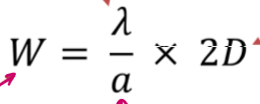
diffraction grating equation
dsinθ = nλ
n = the order
d = grating spacing
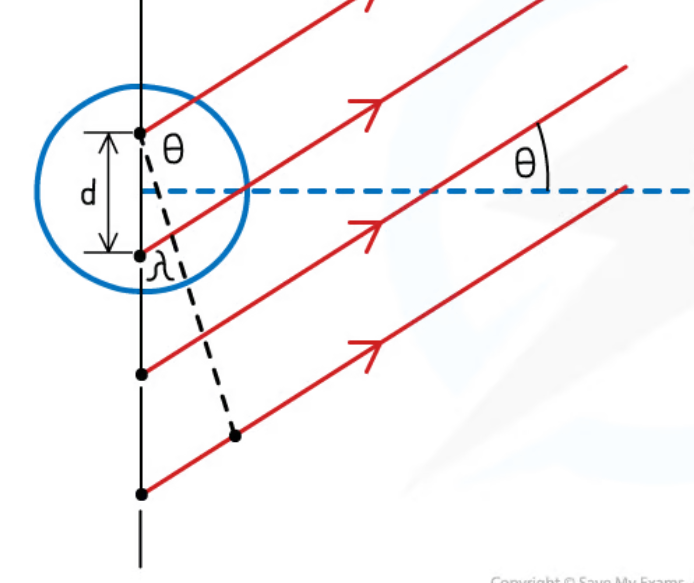
applications of diffraction gratings
spectral analysis of light from stars
analysing composition of stars
measuring red shift/rotation
what is refraction
refraction is the change in direction/bending of light when it enters another medium due to the change in speed(which changes direction).
(partial reflection also occurs when a light ray in air enters glass or any other refractive substance)
what is refractive index + the equation
the ratio of speed in light in a vacuum ( c ) : speed of light in that substance (cs)
for a light ray travelling from air into a transparent substance,
n = sini/sinr

snell’s law of refraction for boundary

what properties of the light wave changes during refraction
frequency remains the same
speed changes - increases when entering less optically dense medium and vice versa
wavelength changes - increases when entering less optically dense medium
define critical angle and total internal reflection
critical angle is the angle of incidence at which a ray of light would have an angle of refraction of 90 degrees and remain inside the denser material
total internal reflection is when a ray of light is completely reflected back into the medium of incidence
conditions required for total internal reflection
angle of incidence is greater than the critical angle
incidence substance has a larger refractive index than the other substance (i.e. entering a less optically dense medium)
critical angle equation:

what are optical fibres used for
used in medical endoscopes to see the inside of the body
communications to carry light signals
how is total internal reflection used to transmit information along an optical fibre?
light transferring information enters core
light travels from core to cladding, which has a lower refractive index
at an angle > critical angle
TIR occurs and continues throughout the fibre
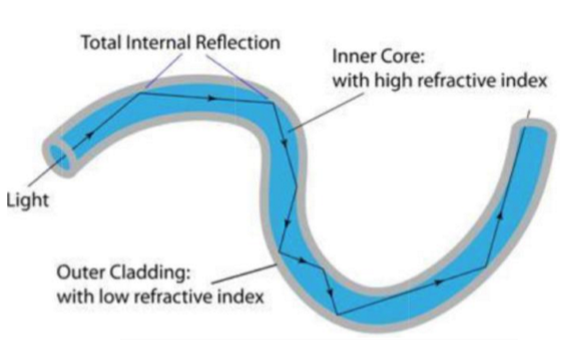

purpose of the cladding (3)
causes total internal reflection
prevents light loss from the core (light going from one fibre to another)
protects the fibre
purpose of the outer sheath (2)
prevents physical damage to fibre i.e. scratches
strengthens the fibre
what is a step index profile
core has a uniform refractive index + there is a sudden change in refractive index at the core-cladding boundary
what are material and modal dispersion
material: different colour light travels at different speeds in any medium apart from a vacuum. if white source was used red would arrive first (travels fastest). to prevent this only monochromatic light is used
modal: occurs when light pulses in the optical fibre spread out due to the different angles of incidence in the original pulse. in wider cores, light travelling along the axis of the core travels a shorter distance than the light undergoing TIR at the core-cladding boundaries (image). prevented by making core narrow.
both lead to pulse broadening
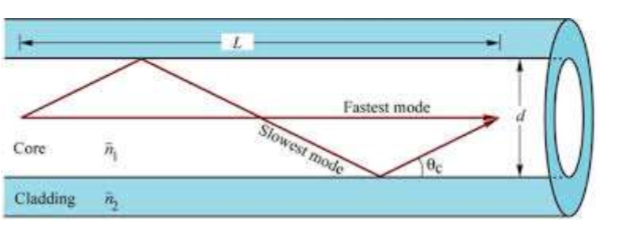
what is pulse broadening
caused by modal and material dispersion
impurities/irregularities in the fibre can cause pulse to be spread out due to dispersion of light.
causes different pulses to merge, leading to a completely distorted final pulse
absorption occurs when.
part of the signal’s energy is absorbed by the fibre therefore signal is changed (reduced in amplitude) → loss of information
to reduce absorption (2)
use core which is extremely transparent: more transparent → less light is absorbed
use optical fibre repeaters so that pulse is regenerated before significant absorption has taken place
to reduce pulse broadening (4)
make core as narrow as possible → reduce possible differences in path length of the signal
use monochromatic light source so that the speed is constant
use optical fibre repeaters so that pulse is regenerated before significant pulse broadening has taken place
use single-mode fibre to reduce multipath modal dispersion